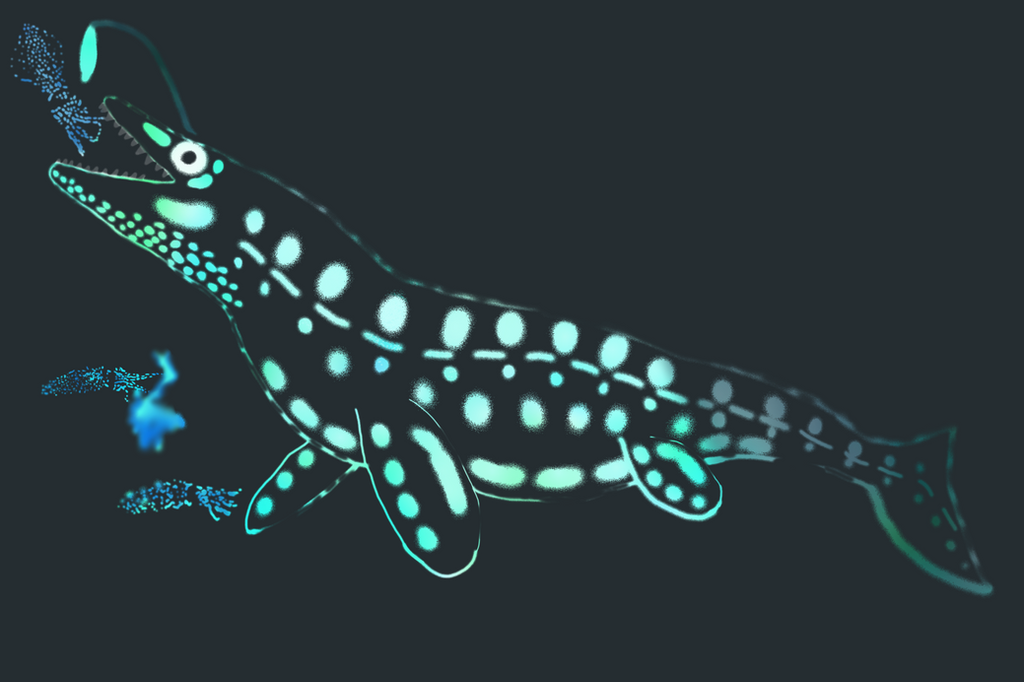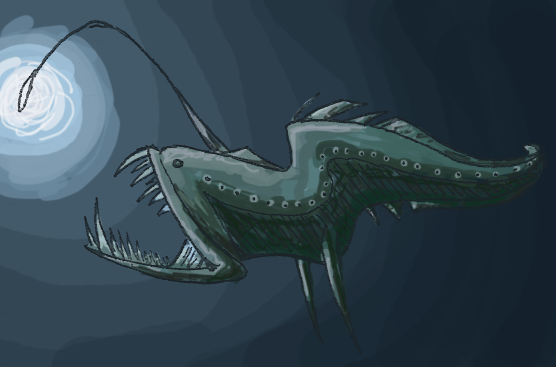HOME | DD
 Olmagon — Deep in the Dark I Don't Need the Light
Olmagon — Deep in the Dark I Don't Need the Light

#anglerfish #glow #scratchart #squid #fireflysquid #bioilluminescent #phosphorosaurus #cretaceous #deepsea #digitalart #digitaldrawing #digitalillustration #digitalpainting #dinosaur #glowinthedark #lizard #marinereptile #mesozoic #mosasaur #neonlights #paleoart #paleontology #subnautica #viperfish #paleoillustration #speculativepaleoart
Published: 2020-08-26 08:59:54 +0000 UTC; Views: 3946; Favourites: 52; Downloads: 4
Redirect to original
Description
66 million years ago (in the Maastrichtian of the late Cretaceous period) in the deep ocean waters of what will become the Hakobuchi Formation in Hokkaido, Japan, some bioilluminescent squid flash their blue lights to attract mates and ward off rivals of their own gender, but their light show is noticed by another glowing deep-sea creature. A Phosphorosaurus ponpetelgans, a 3-meter long mosasaur (basically a marine lizard for those who don’t know) has picked up the glow of the squids with its large eyes and approaches them. It waves a fleshy lure with a glowing tip that sticks out of its head around. One of the squid has mistaken this fleshy appendage for a luminescent fish and tries to hunt it, but as it gets close the mosasaur suddenly lunges at it, grabbing its prey with sharp teeth. The other squids, which mistaken the glowing organs of the reptile for the glow of their own kind, now realise the danger and start escaping and squirting glowing ink in an attempt to keep their lives.Phosphorosaurus is a halisaurine mosasaur known for having large eyes, which indicate it was probably a deep-sea animal. And then I decided to add wild speculation because I love speculative paleoart. Many deep sea animals have evolved bioilluminescence and can produce light, so what if a deep sea marine reptile may have evolved this feature as well? Not necessarily Phosphorosaurus, but considering the large number of known Mesozoic marine reptiles and that we probably only know of a small portion of the number of species that once lived, is it that crazy to think at least one would have evolved to produce some extent of light at all? Well this reconstruction is probably crazy wild given the extent of the lights. I have put rows of light-producing organs along the length of its body, mostly based on those of viperfish and lanternfish. And then I went further and even put a fleshy lure on its head. Such extensions with glowing tips are known from anglerfish, dragonfish and more, although in most of these fish the lure is an extension of the dorsal fin rather than fleshy. But fleshy lures are known in the animal kingdom: snapping turtles have worm-like tongues which they use to attract fish, and while this isn’t a tongue I thought that forehead foreskin that glows is okay.
The squid are no specific species, but mostly based on the modern day firefly squid (Watasenia scintillans) which lives in Japanese waters and also can produce blue light. I guess this could be deemed a hypothetical Cretaceous-age ancestor of the modern firefly squid. Since squid (and just most cephalopods in general) have no hard parts other than the beak their fossil record kinda freaking sucks. Ammonites have it way better. Say, who knows, maybe there was once a glowing deep-sea ammonite.
Related content
Comments: 11

👍: 0 ⏩: 1

👍: 0 ⏩: 0

👍: 0 ⏩: 1

👍: 0 ⏩: 0

👍: 0 ⏩: 1

👍: 0 ⏩: 0

👍: 0 ⏩: 1

👍: 0 ⏩: 1

👍: 0 ⏩: 1

👍: 0 ⏩: 1

👍: 0 ⏩: 0
























